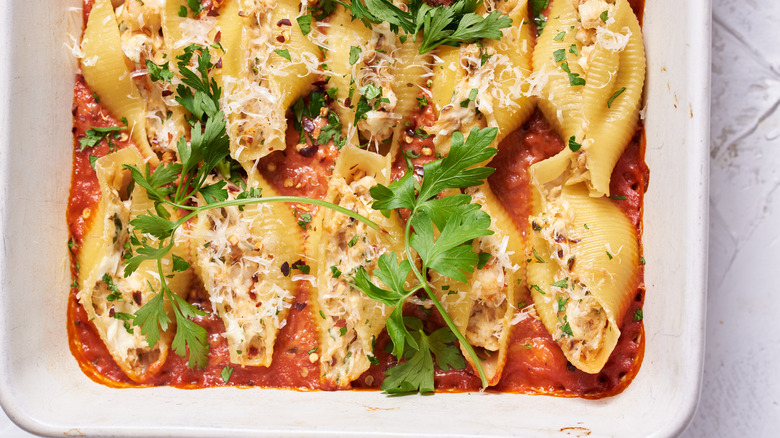You Shouldn't Freeze Leftover Seafood-Stuffed Shells. Here's Why
The freezer can be an excellent tool for meal prep; certain recipes hold up well when frozen and can be reheated into an easy, ready-made meal in minutes. However, some dishes don't maintain their quality as well due to the nature of specific ingredients within the dish. Tasting Table recipe developer Michelle McGlinn's creamy seafood-stuffed shells are a delicious dish when fresh, but freezing the shells can result in a lackluster texture, and the same goes for most dishes with large amounts of creamy components. This is because when dairy is frozen, the fat separates from the liquid in the dairy, causing a gritty or even curdled texture.
The reason you don't see this with dishes such as ice cream is that the sugar helps lower the freezing point of the liquids in it and maintain a smooth, even texture. Meanwhile, your average, homemade dishes aren't going to utilize the necessary food science to obtain these results. While freezing leftovers or large portions of dishes can be handy, it's recommended to avoid doing so with extra creamy recipes. As for recipes that use a small amount of dairy, those can still be frozen.
How to best store and reheat seafood-stuffed shells
Instead of freezing, McGlinn recommends storing the seafood shells in an airtight container in the fridge, where the shells will stay good for up to a week. You can even portion the shells into single-serving containers and have a week's worth of grab-and-go lunches. When thinking of the best type of container to store the shells in, your typical Tupperware or Pyrex storage should fare just fine. A bonus of using Pyrex storage containers is that they are oven and microwave-safe so it's simple to heat your food and enjoy. Just be sure to bring your Pyrex to room temperature before placing it in the oven.
When reheating your shells, you can opt for a microwave or oven. If you use a microwave, lay your shells out in a flat layer in a microwave-safe container and add a little more sauce on top to help rehydrate the food and keep it moist. If you don't have extra sauce, you can use a splash of water on each shell to create that moisture. You'll then microwave them for a minute to start, and from there you can check in 15-second intervals to see if your food has heated through. If you plan on using an oven to reheat the shells, you'll also lay them out in a single layer in an oven-safe dish. You'll then cover it with foil and bake at 375 degrees Fahrenheit until your food reaches an internal temperature of 165 degrees Fahrenheit, as per USDA guidelines.

